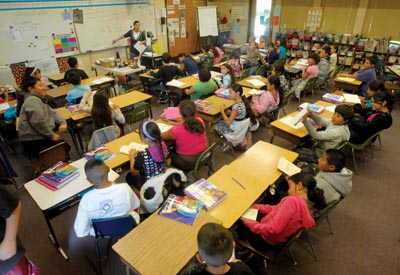With a decreasing cash flow and less money from the state, the
Hollister School District has fallen into a financial crisis and is
considered by the California Department of Education as a district
of negative certification, forcing it to cut more than $2.5 million
from its budget before June 30.
With a decreasing cash flow and less money from the state, the Hollister School District has fallen into a financial crisis and is considered by the California Department of Education as a district of negative certification, forcing it to cut more than $2.5 million from its budget before June 30.
With the possible inability to pay its bills by the 2012-13 school year, the district is in the final steps before a possible state takeover. If that would happen, the state would assign an administrator that would have fiscal oversight over the district, ridding the school board of its control. The state-assigned administrator would replace the current superintendent.
“The story has been unfolding for quite some time now,” Hollister School District Superintendent Gary McIntire said.
Operating at 18 percent deficient, the district must cut an additional $2.5 to $2.75 million from its $40 million budget in each of the next two years, said Ron Wheelehan, assistant superintendent of the San Benito County Office of Education. If the district can’t do that and it runs out of cash flow, the state’s department of education will take over.
“They are not there yet, but if the board doesn’t take action, they will be,” he said. “They have the same cost and they need to cut some of it.”
Because of the statewide budget issues, the state has been funding the district at only 82 percent of what was projected three years ago, Wheelehan said. The gap has been filled by budget cuts over the last few years, including $6.5 million last year, but more is needed as the district continues to lose money.
“It looks like they have enough (cash) this year, but two years out, we see a problem,” Wheelehan said.
The state stopped paying the district its full revenue limit, or expected funding, once the economy slowed, McIntire said. The cut in funding was the district’s “tipping point.”
“The district has been dealing with that but we have continued to seek additional support,” he said.
Under the state and Assembly Bill 1200, each district must construct its budget three years in advance, Wheelehan said. Each district must show the ability to pay for its bills up to two years after the current school year. If it can’t, a district could get listed as a district of negative certification.
The negative certification is the third, and worst tier, of a three-tier system that rates the districts on their financial abilities. A positive certified school shows no issues of an inability to handle its financial responsibilities over three years. A qualifying school can handle its budget during the current year but “may not” be able to in the following two years.
Assembly Bill 1200 was passed in 1991, in response to the bankruptcy of the Richmond School District. Legislators set up the bill to prevent districts from falling under the same financial crises, allowing the county’s office of education or the state to intervene.
As of now, the “negative certification” declaration forces the district to hire a financial adviser who “shadows the budget process” of the district, said Debbie Boothe, vice president of the Hollister Elementary School Teachers’ Association.
Earlier this month, the district hired Maureen Evans of School Services of California to be its financial adviser.
Evans, working with a Budget Advisory Committee one day a week throughout October, looked for areas where cuts could be made. The committee was an advisory group for McIntire that started in mid-September and ran through to the last Tuesday in October. It consisted of 17 members involved with the school, including teachers, parents and the business community.
Eventually, Evans is expected to help the district find where cuts can be made, McIntire said.
But still, the district is fighting to keep control of its budget.
“A lot is still up in the air, whether we survive or not,” Boothe said.
She warned that more cuts to services and teachers could be on the horizon, worsening an already increased class-size total.
“They could go after salaries, after retirement packages, after benefits,” Boothe said. “These are the targets.”
Despite the looming cuts, McIntire expressed the need to prevent the cuts from affecting students or classrooms.
“These are unprecedented times,” he said. “We will get through this, but it’s going to be difficult. We have some work to do, but we can’t allow it to have any effect on our classrooms.”
McIntire warned that the district would need to eliminate extra circular activities.
“Right now we are in a pattern of survival and we are not able to do a lot more than the basics,” he said.










